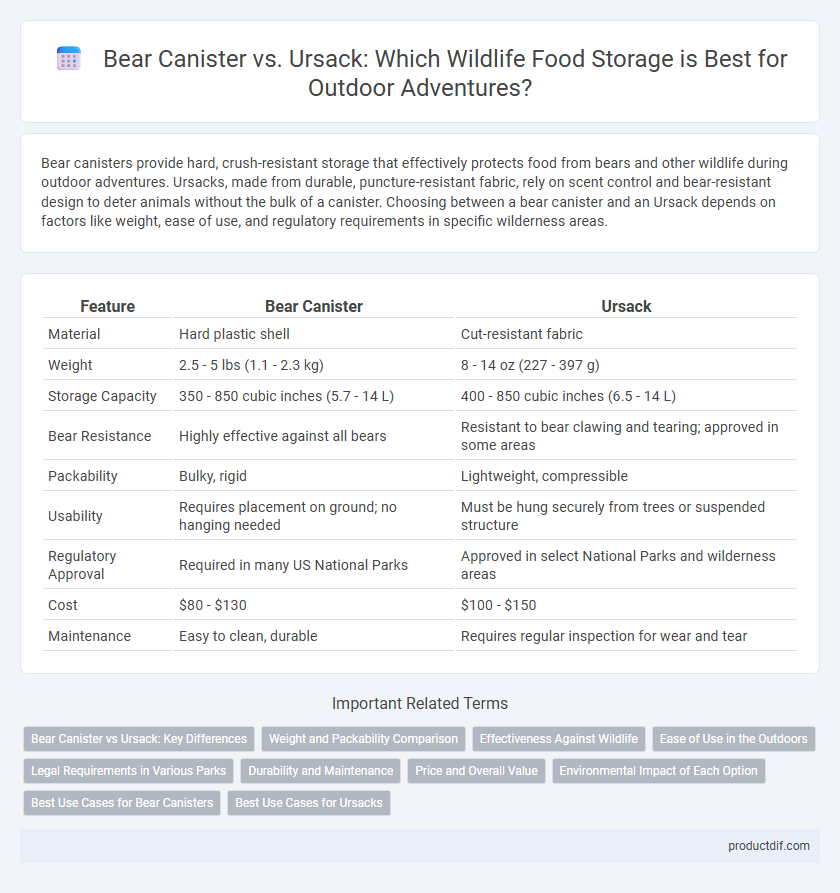Bear canisters provide hard, crush-resistant storage that effectively protects food from bears and other wildlife during outdoor adventures. Ursacks, made from durable, puncture-resistant fabric, rely on scent control and bear-resistant design to deter animals without the bulk of a canister. Choosing between a bear canister and an Ursack depends on factors like weight, ease of use, and regulatory requirements in specific wilderness areas.
Table of Comparison
| Feature | Bear Canister | Ursack |
|---|---|---|
| Material | Hard plastic shell | Cut-resistant fabric |
| Weight | 2.5 - 5 lbs (1.1 - 2.3 kg) | 8 - 14 oz (227 - 397 g) |
| Storage Capacity | 350 - 850 cubic inches (5.7 - 14 L) | 400 - 850 cubic inches (6.5 - 14 L) |
| Bear Resistance | Highly effective against all bears | Resistant to bear clawing and tearing; approved in some areas |
| Packability | Bulky, rigid | Lightweight, compressible |
| Usability | Requires placement on ground; no hanging needed | Must be hung securely from trees or suspended structure |
| Regulatory Approval | Required in many US National Parks | Approved in select National Parks and wilderness areas |
| Cost | $80 - $130 | $100 - $150 |
| Maintenance | Easy to clean, durable | Requires regular inspection for wear and tear |
Bear Canister vs Ursack: Key Differences
Bear canisters provide rigid protection against bear encounters by securely locking food containers in a durable, hard-shell case, essential for areas with aggressive bear populations. Ursacks, made from flexible, cut-resistant fabric, rely on scent containment and durability rather than physical strength, offering a lighter and more packable alternative. Choosing between a bear canister and an Ursack depends on specific wilderness regulations, weight considerations, and the level of bear activity in the area.
Weight and Packability Comparison
Bear canisters are typically made from hard plastic, resulting in heavier weight ranging from 2.5 to 4 pounds and bulkier dimensions that require more pack space. Ursacks, constructed from ultra-high-molecular-weight polyethylene fabric, weigh significantly less--around 8 to 16 ounces--and offer superior packability due to their flexible, compressible design. Choosing between a bear canister and an Ursack depends largely on balancing the ease of carrying lighter, more compact protection against the rigid, heavier, but highly durable hard-shell option.
Effectiveness Against Wildlife
Bear canisters provide a hard, durable barrier that effectively prevents bears and other large wildlife from accessing food by withstanding strong bite forces and scratching. Ursacks use a puncture-resistant fabric that relies on the animal's inability to crush or tear through the material, proving effective mostly against bears but less so against smaller critters. Studies show bear canisters are generally more reliable in high-bear-density areas, while Ursacks offer lightweight, packable protection suitable for lower-risk environments.
Ease of Use in the Outdoors
Bear canisters offer straightforward ease of use with rigid, secure containers that require minimal setup and can be quickly sealed and carried. Ursacks provide flexibility through lightweight, packable fabric sacks that conform to gear but need proper suspension techniques for optimal effectiveness. Both options balance user convenience and bear safety, with bear canisters favoring simplicity and Ursacks emphasizing packability.
Legal Requirements in Various Parks
Bear canisters meet legal requirements in many U.S. national parks such as Yosemite and Rocky Mountain, where hard-sided containers are mandatory to prevent bear encounters. Ursacks, made from durable fabric, are approved in fewer parks and typically only where soft-sided bear-resistant bags are permitted, like some areas in the Wind River Range. Understanding specific park regulations is essential since improper storage can lead to fines or wildlife disturbances.
Durability and Maintenance
Bear canisters offer robust, rigid protection against bears with durable hard plastic shells that resist impacts and crushing, requiring minimal maintenance beyond regular cleaning. Ursacks are made from ultra-high molecular weight polyethylene fibers, providing lightweight, tear-resistant solutions but needing occasional inspection to ensure the fabric integrity is uncompromised. The solid construction of bear canisters generally guarantees longer lifespan, while Ursacks demand careful handling to maintain durability and effectiveness.
Price and Overall Value
Bear canisters typically range from $80 to $150, offering rigid, proven protection against bears but can be bulky and heavy. Ursacks cost between $60 and $100, providing lightweight, packable protection with high durability, though they rely on bear-resistant materials rather than rigid barriers. Considering price, Ursacks deliver better overall value for backpackers prioritizing weight and portability, while canisters suit those needing maximum security in high-risk bear areas.
Environmental Impact of Each Option
Bear canisters, typically made from hard plastic, offer robust wildlife protection but pose environmental concerns due to their non-biodegradable materials and energy-intensive manufacturing. Ursacks, constructed from high-strength fabric, minimize environmental footprint through lightweight design and lower material use, though they require careful disposal to prevent microplastic pollution. Choosing between the two involves balancing durable wildlife deterrence with sustainable resource impact in outdoor gear selection.
Best Use Cases for Bear Canisters
Bear canisters are best suited for backpackers venturing into federally designated wilderness areas where regulations require hard-sided food storage to prevent bear encounters. Their rigid, puncture-resistant design offers superior protection against persistent and intelligent bears, making them ideal for long-term trips in regions with high bear populations. Lightweight options exist, but bear canisters generally provide more reliable odor containment and physical security compared to soft-sided alternatives like Ursacks.
Best Use Cases for Ursacks
Ursacks are best suited for backpackers and minimalist campers who prioritize lightweight and compact food storage solutions in bear country. Their soft, flexible design allows them to be easily packed and hung from trees, making them ideal for environments where hard-sided bear canisters are cumbersome or prohibited. Ursacks are especially effective in dense forests and alpine terrains where carrying heavy gear is impractical but scent containment from bears is essential.
Bear Canister vs Ursack Infographic

 productdif.com
productdif.com